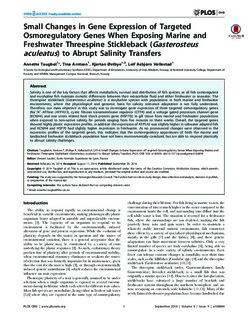Small Changes in Gene Expression of Targeted Osmoregulatory Genes When Exposing Marine and Freshwater Threespine Stickleback (Gasterosteus aculeatus) to Abrupt Salinity Transfers
Original version
Taugbøl A, Arntsen T, Østbye K, Vøllestad LA (2014) Small Changes in Gene Expression of Targeted Osmoregulatory Genes When Exposing Marine and Freshwater Threespine Stickleback (Gasterosteus aculeatus) to Abrupt Salinity Transfers. PLoS ONE 9(9): e106894. doi:10.1371/journal.pone.0106894 10.1371/journal.pone.0106894Abstract
Salinity is one of the key factors that affects metabolism, survival and distribution of fish species, as all fish osmoregulate and euryhaline fish maintain osmotic differences between their extracellular fluid and either freshwater or seawater. The threespine stickleback (Gasterosteus aculeatus) is a euryhaline species with populations in both marine and freshwater environments, where the physiological and genomic basis for salinity tolerance adaptation is not fully understood. Therefore, our main objective in this study was to investigate gene expression of three targeted osmoregulatory genes (Na+/K+-ATPase (ATPA13), cystic fibrosis transmembrane regulator (CFTR) and a voltage gated potassium channel gene (KCNH4) and one stress related heat shock protein gene (HSP70)) in gill tissue from marine and freshwater populations when exposed to non-native salinity for periods ranging from five minutes to three weeks. Overall, the targeted genes showed highly plastic expression profiles, in addition the expression of ATP1A3 was slightly higher in saltwater adapted fish and KCNH4 and HSP70 had slightly higher expression in freshwater. As no pronounced changes were observed in the expression profiles of the targeted genes, this indicates that the osmoregulatory apparatuses of both the marine and landlocked freshwater stickleback population have not been environmentally canalized, but are able to respond plastically to abrupt salinity challenges.
